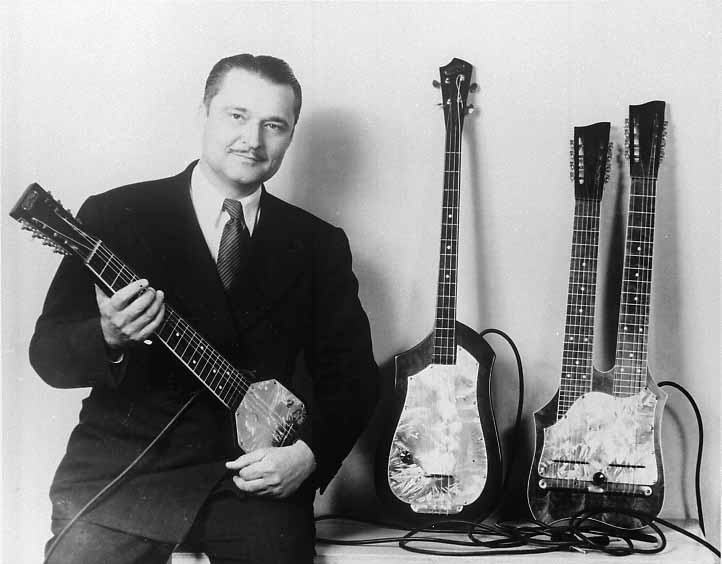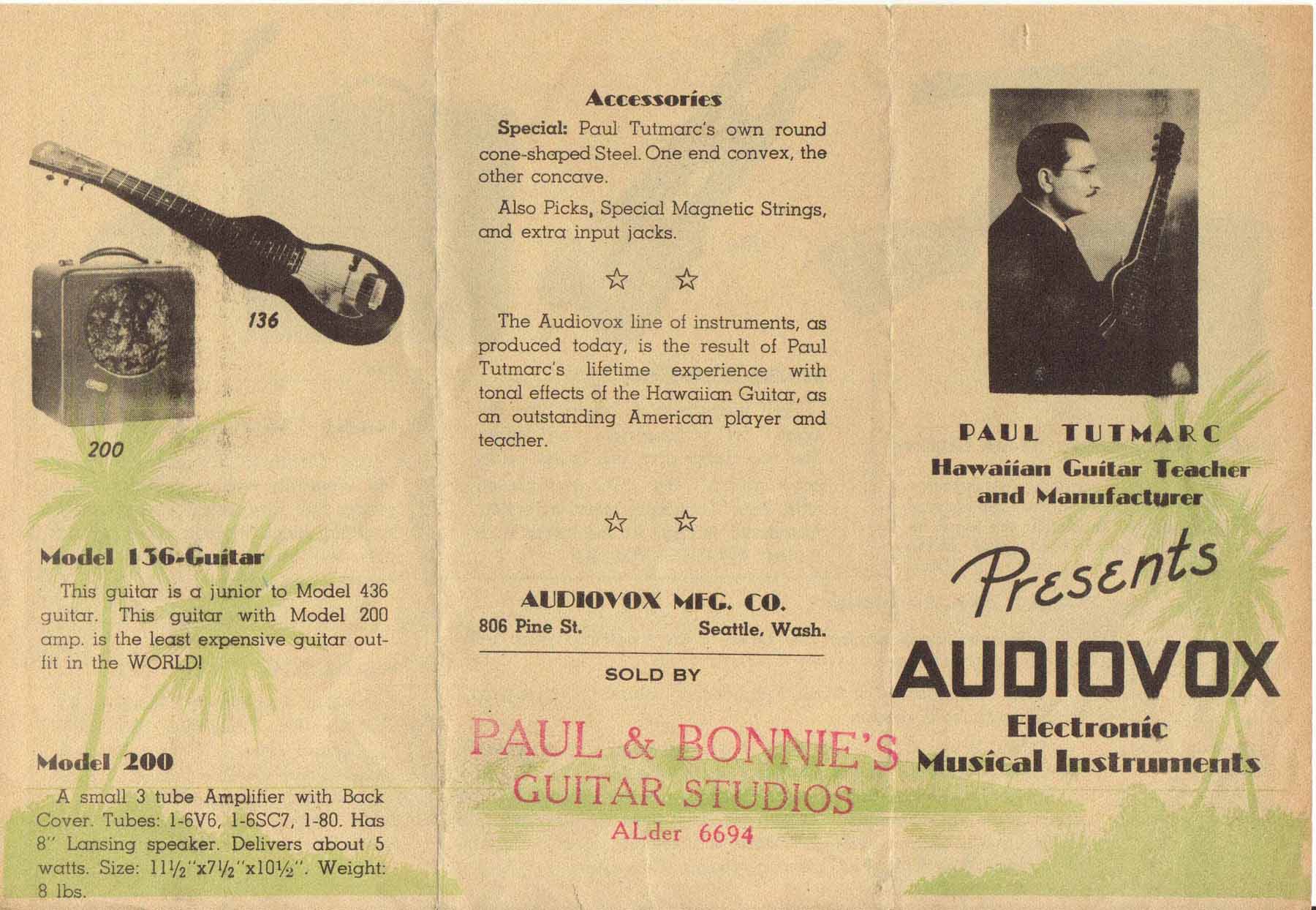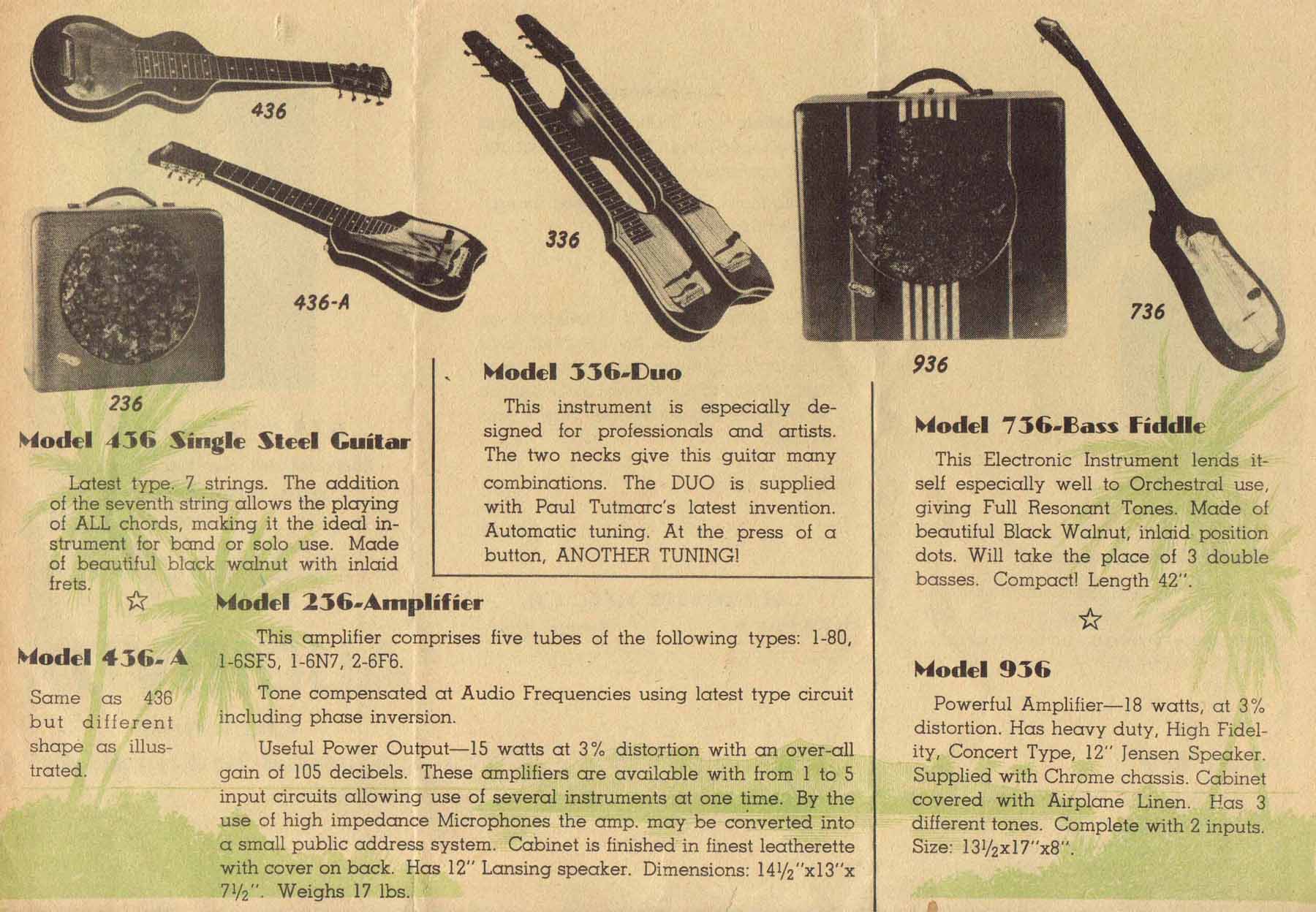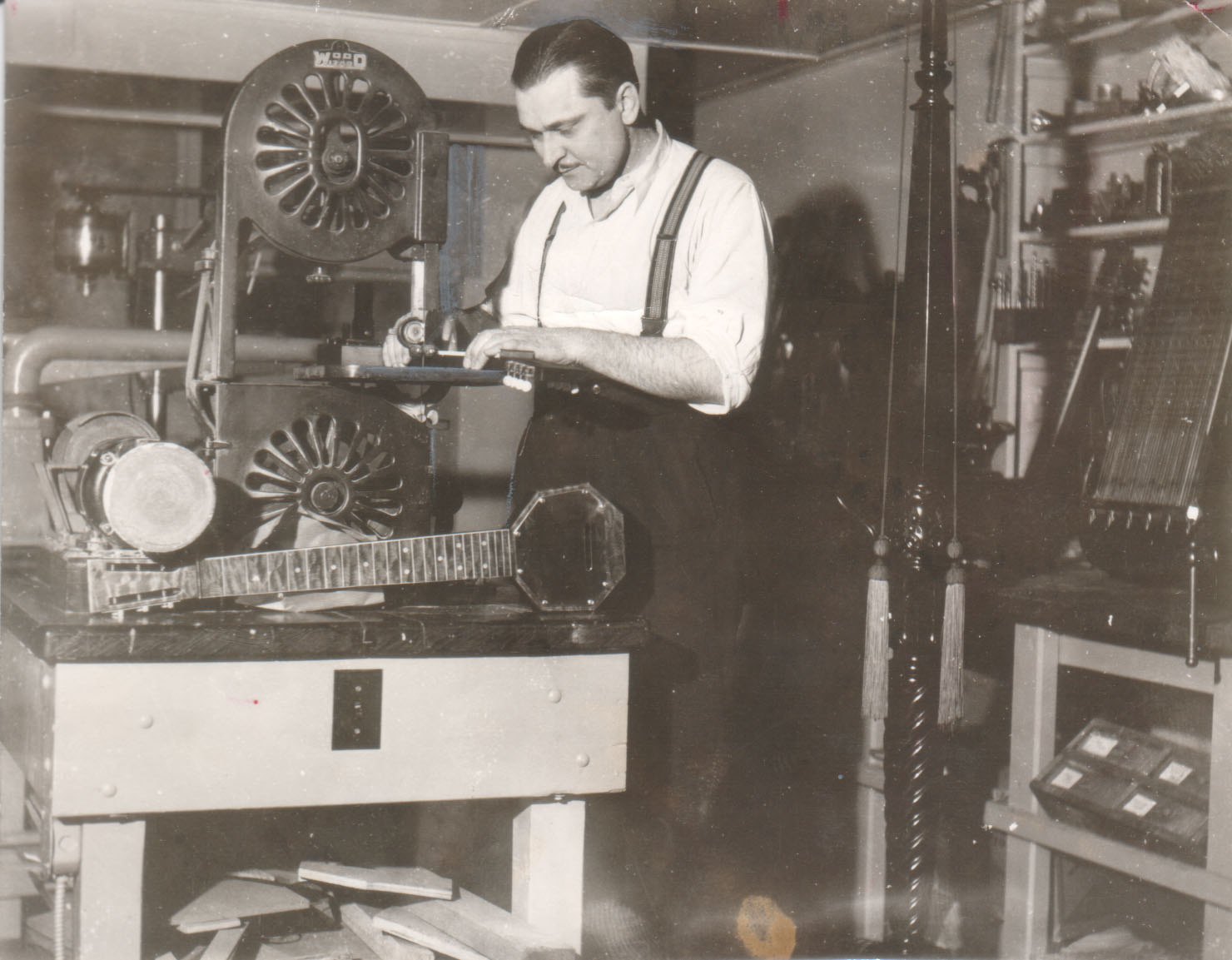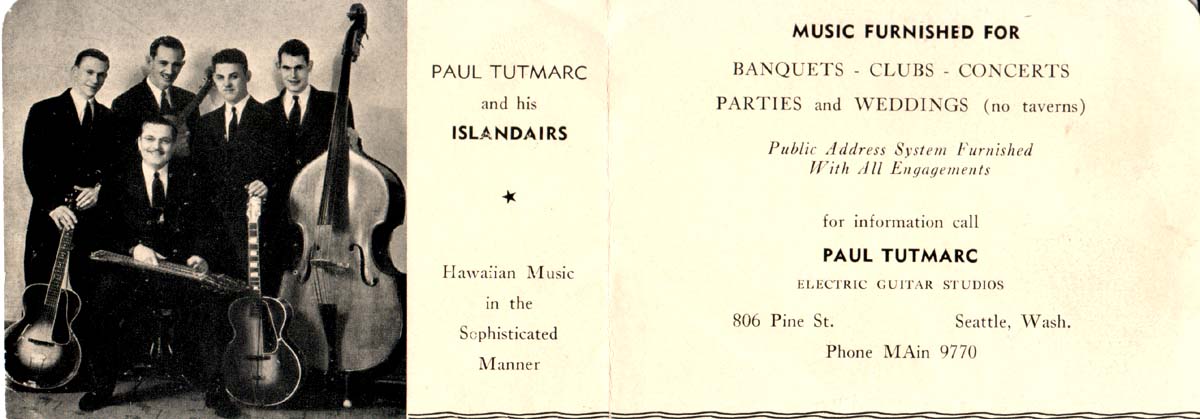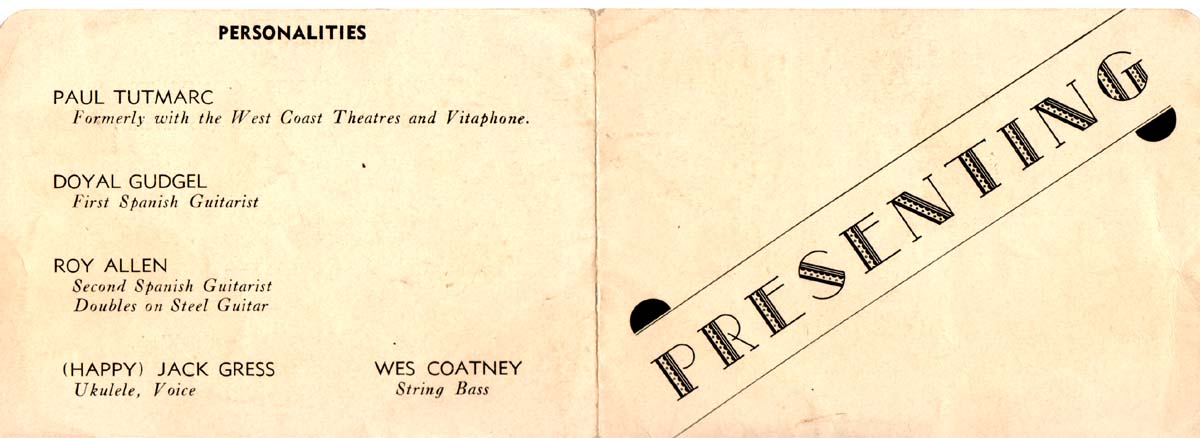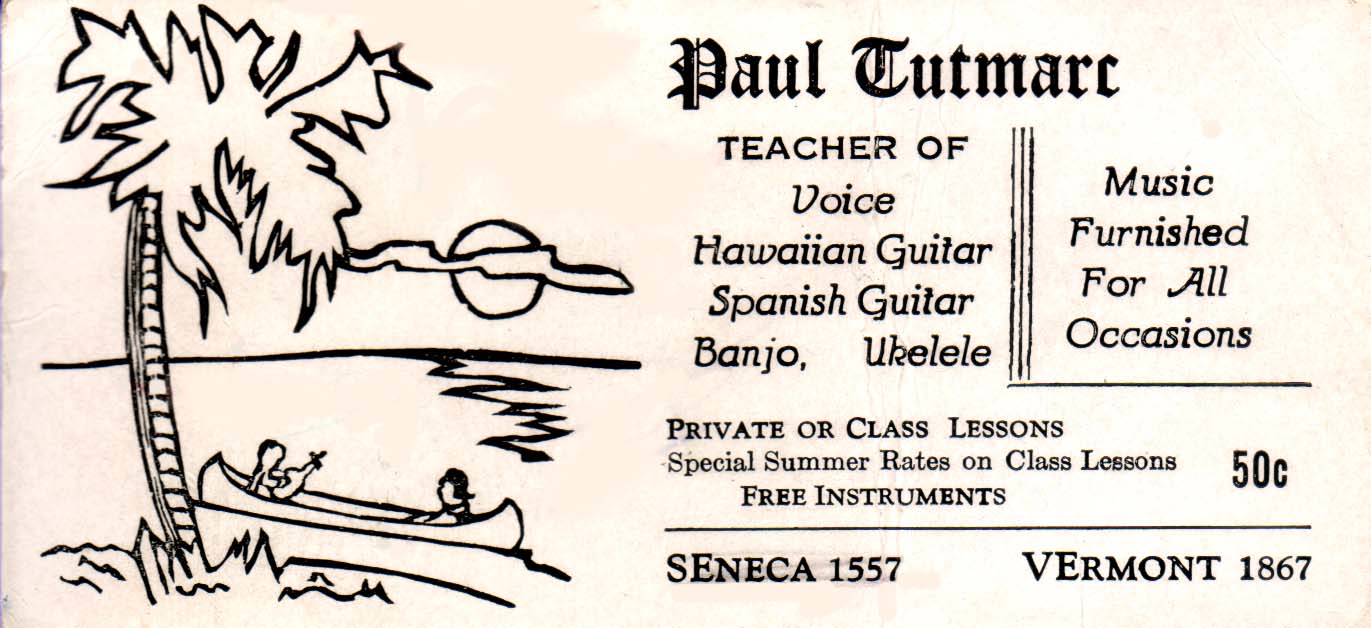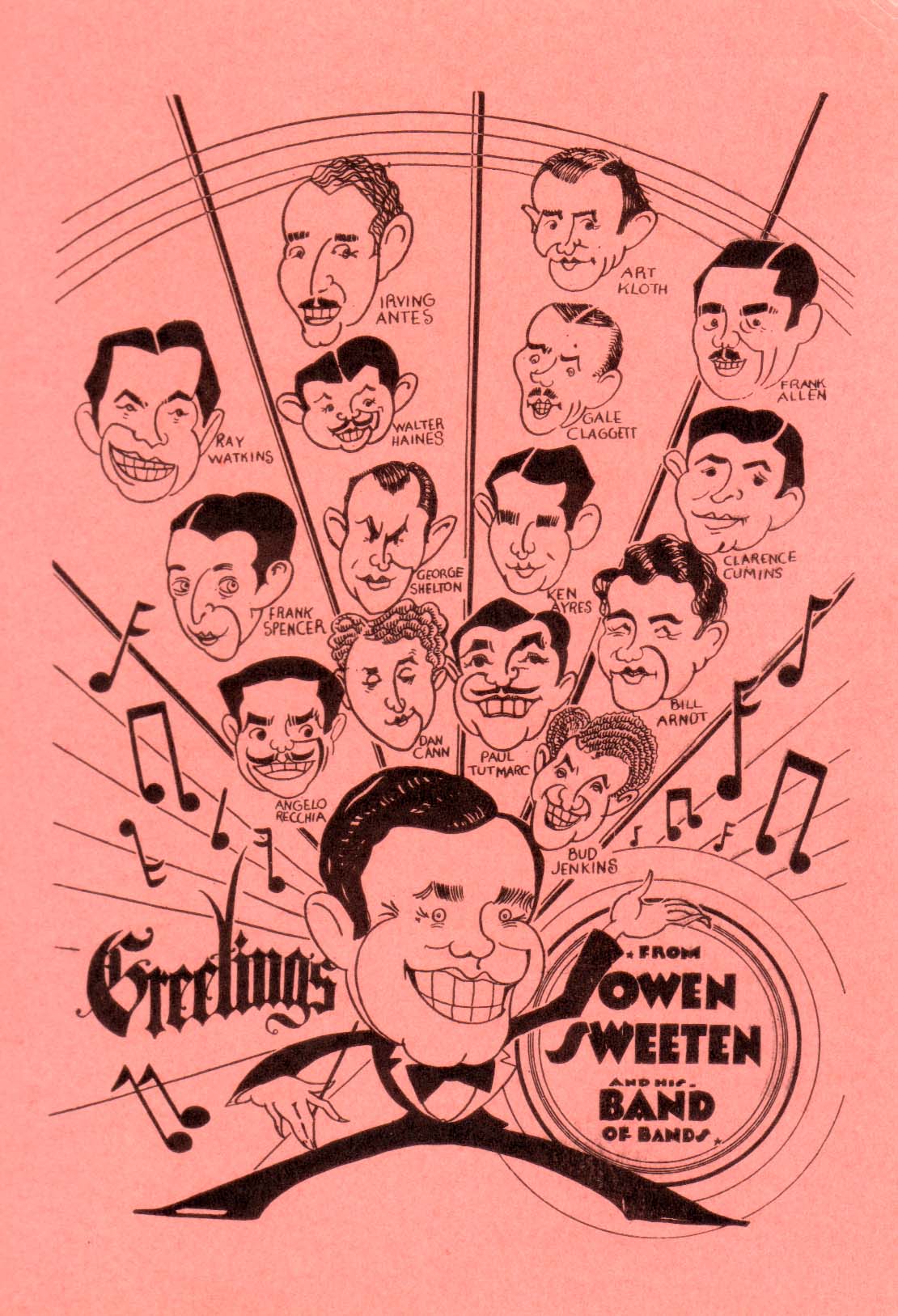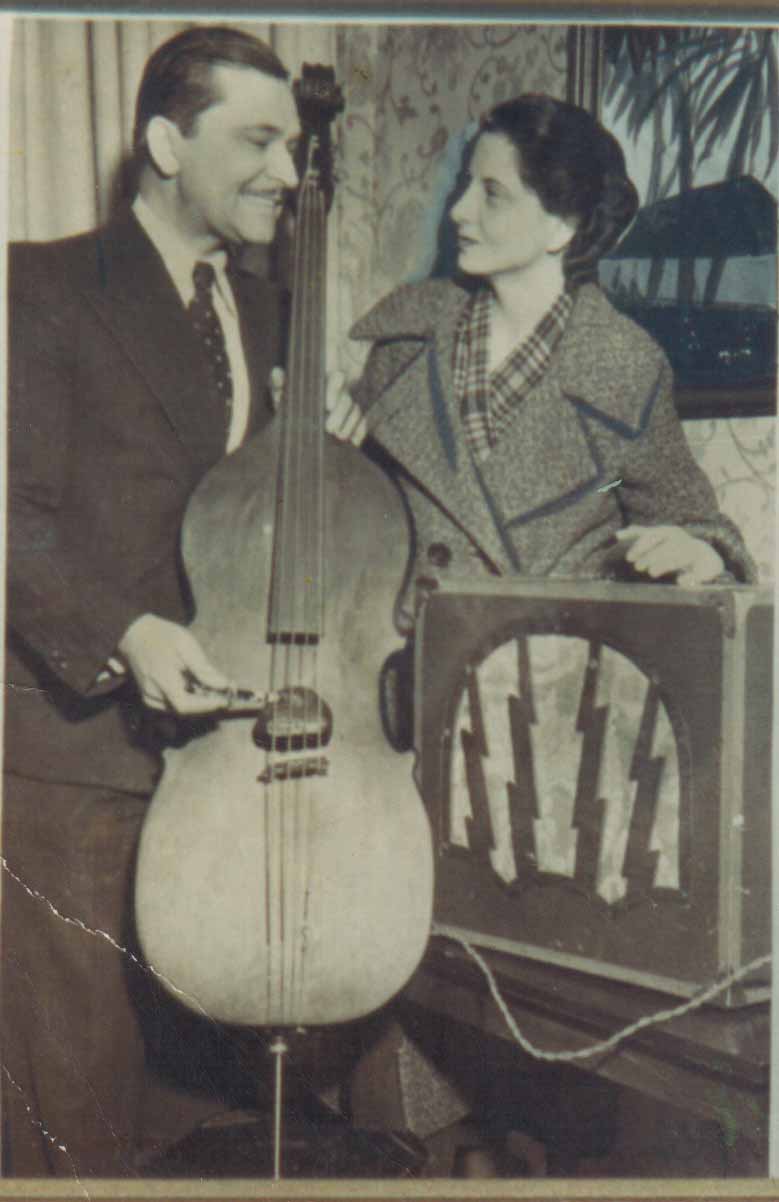

by Bud Tutmarc
I have been urged by many persons over the years to write the TRUE FACTS regarding the creation of the very first electric guitar, which was an electric Hawaiian guitar because the inventor was an accomplished artist on the Hawaiian guitar.
I am speaking of my father, Paul H. Tutmarc.
My dad had a love for the Hawaiian Steel guitar from the time he was 15 years old. This was about the year 1911 as my father was born in Minneapolis, Minnesota on May 29, 1896.
He started playing the guitar at that age and a few years later got a Knutsen Hawaiian steel guitar and practiced hours and hours everyday. He married my mother, Lorraine, in 1921 and I joined the family on July 11, 1924 after my sister Jeanne, who was born on December 7, 1922. We lived in Centralia, Washington, my first four years. My dad was the local band leader for the dances, playing banjo and singing and leading the band. We moved to Seattle in 1928 (I was four years old) and my father built us a very good home in Seattle. This house had a fine, full basement, and my dad, being such an ambitious person, had a very complete workshop in the basement by the time the house was finished. My father and his brother did all the carpentry work on the house.
My dad was the tenor soloist in several of the downtown theaters in those days. He worked on the Fanchon & Marco circuits and was much involved in music as well as being an instructor of the Hawaiian guitar. He gave many lessons in our home and I was a constant "listener" from behind the living room sofa.
In the later part of 1930 or perhaps the very first of 1931, a man, Art Stimpson, from Spokane, Washington, came to Seattle, especially to see and meet my father. Art was an electrical enthusiast and always taking things apart to see what made them function as they did. He had been doing just this with a telephone, wondering how the vocal vibrations against the enclosed diaphragm were picked up by the magnet coil behind the diaphragm and carried by the wires to another telephone. My father became interested in this "phenomenon" and began his own "tinkering" with the telephone. Noting that taping on the telephone was also picked up by the magnetic field created behind the diaphragm, he was encouraged to see if he could build his own "magnetic pickup".
As every, old time steel player knows, it was difficult to make the steel guitar heard above other instruments. My father was always complaining about this common problem. The Dobro guitars with the aluminum dishes inside did help, somewhat, but never enough for performance with any goodly number of accompanists.
The very first though of my father's was, with this idea of magnifying sound, electrically, how could this magnify the sound of his steel guitar. He started with a rather large, horse-shoe shaped magnet, wound some coils with the smallest wire he could obtain, which was either No. 38 or No. 40. I remember seeing this first magnetic pickup of his. It was all wrapped up in friction tape and about the size of a grapefruit.
He made contact with another friend, Bob Wisner, a young man with a brilliant mind, and a radio repairman of great repute in Seattle as about the only one able to repair the old Atwater-Kent radios. He worked at Buckley Radio in Seattle, on Saturdays, repairing all the radios the regular repairmen could not repair during the week. It was Bob Wisner who helped my dad re-wire a radio to get some amplication of his magnetic pickup.
Once this was ready, my dad starting working with an old round hole, flat top guitar and discovered the pickup would pick up the sound from a plucked string and carry it through to the "adapted" radio. So, this large pickup was eventually installed INSIDE the guitar with a polepiece sticking up through a slot he cut in the top of the guitar near the bridge, and the electric guitar was on its way. Being an ambitious woodworker, he decided to make a solid body for his electric guitar idea and his first one was octagon shaped at the bridge end, containing the pickup and then a long, slender square cornered neck out to the patent heads.
Before he actually made this solid body guitar, he electrified every instrument he could get his hands on. He electrified zithers and pianos and spanish guitars. He would break up two guitars, just to get the necks and fretboards and glue them on to a flat top guitar, having three necks with three different tunings. He made a solid body (black walnut) guitar with FIVE sets of strings. The guitar was about 24 inches wide and the neck about 20 inches wide. He had a full, six string major chord, six string seventh chord, six string diminished chord, six string augmented chord and six string ninth chord. I can remember his demonstrating this "out of this world" guitar at the local Sears-Roebuck store in South Seattle.
He began to receive much interest concerning this new invention from his students. He began to see the possibilities on manufacturing these guitars for sale. He did send in to the U.S. Patent office for information regarding any type of electric, stringed instruments. A complete search was made, which I recall cost him $300.00 which in the time of the great depression, was a LOT OF MONEY. There were NO types, whatsoever, presented to the U.S. Patent office, so my dad knew he was the FIRST. However, the chances of patenting an electric pickup would be nil as Bell & Company had long since covered that.
After building a few guitars out of solid, black walnut, he felt he needed to get someone else to do the woodworking and he would go do all the assembly work and electrical manufacturing. He contacted a man, Emerald Baunsgard, a young superb craftsman, and an agreement was made and Emerald started doing all the wood work of the electric guitars for my father's company, Audiovox Manufacturing Company. Emerald was a master at inlay work so these black walnut guitars all had inlaid frets, inlaid pearl position markings and beautiful, hand rubbed finishes. The guitars were beautiful and very quickly accepted on the market.
My dad made solid body spanish guitars but they were not readily received.
My dad, being a band leader and traveling musician, always felt sorry for the string bass player as his instrument was so large that once he put it in his car, there was only enough room left for him to drive. The other band members would travel together in a car and have much enjoyment being together while the bass player was always alone. That is the actual idea that got my father into making an electric bass. The first one he handcarved out of solid, soft white pine, the size and shape of a cello (see photo above). To this instrument he fastened one of his "friction tape' pickups and the first electric bass was created. This was in 1933.
The idea of the electric bass was very important to him but he was so dissatisfied with his solid body "cello size" bass that he made a 42 inches long, solid body bass out of black walnut, like his guitars, and the electric bass was launched. The cello sized bass was too heavy and not really accomplishing what he set out to do: wanting to create an instrument, small and light-weight, yet capable of producing more sound than several upright, accoustic basses. My father advertised his electric guitars, single necked steel guitars and double necked steel guitars AND his new electric bass in a local school's 1937 Yearbook. That certainly establishes a definite date. I personally played the electric bass in John Marshall Junior High School, here in Seattle, in 1937 and 1938.
Not only did my father manufacture the electric guitars and basses, he also made amplifiers. His amplifiers were designed by the same Bob Wisner who helped him with the radio-turned- amplifier. Incidently, this same Bob Wisner went on to great heights in scientific work. He worked on the Atom Bomb in Wendover, Utah and in Alamagordo, New Mexico. After the war he as with the Boeing Company working on the Bomarc missile program. He eventually went to Cape Canaveral, which became Cape Kennedy, and worked with the moon rockets. It was tragic in that while the first astronauts were on their way to the moon, Bob Wisner passed away. He knew they lifted off but never knew they made a successful landing.
Sol Hoopii, the greatest Hawaiian steel guitarist of all time, was my father's idol. My dad would get every record Sol would make and practically wear it out playing it over and over again and trying to learn each song as Sol would play it. It was our joy to meet Sol Hoopii personally in 1942 and we were all very close for the next 11 years until Sol's death, here in Seattle in 1953.
It was my pleasure to play with Sol on many, many occasions in many places in the United States. Sol's widow, Anna Hoopii, lives here in Seattle and we see each other about every other week.
My father continued to manufacture his instruments for many years. He sold many of his electric basses to travelling music groups.
When I was about 11 or 12 years old, I started winding the coils for the pickups and wiring the amplifiers for my dad. This continued for four or five years. I married Opal Ogden in 1945. I was working in a machine shop in South Seattle but always wanted to get out of that shop and get into some form of music. I started playing the Hawaiian Steel Guitar when I was six years old.
My father was my first instructor. I, like my father, appreciated the stylings and abilities of Sol Hoopii and imagine what a thrill it was for me, at the age of 18 years, to personally meet Sol and play rhythm guitar for him.
When I got married in 1945, Sol Hoopii was our first house guest! He stayed with us for a week. He was playing in concerts around the city of Seattle and I played rhythm for him. What fantastic memories.
Soon after I was married, I started making electric guitars myself. I also made electric basses and they were distributed by L.D. Heater Music Co., in Portland, Oregon. They put out a nice brochure advertising my Serenader electric bass. This was the first time a large distributor handled the electric bass and we sold many through the efforts of L.D. Heater Music Co.
During this time, in about the year 1948, I was making a guitar for a very excellent Hawaiian Steel Guitarist, Ray Morales. Ray had a very extensive ability on the Steel and upon occasion, played a lot of rhythm on the bass strings. He wanted a guitar that would give him more depth of sound on the bass strings. In an attempt to find a way to have the steel guitar give more depth on the bass strings, I took a pickup, outside of a guitar, and placed it in various places over the strings. I found that putting the pickup about six inches IN FRONT of the bridge gave much more depth of sound from the strings. Upon discovering this result, I changed all my pickups on my electric basses to some six inches from the bridge. This is still prevelant in basses today.
Also, while "fooling around" with this pickup, I found that slanting the pickup so that the polepiece would be farther from the bridge under the bass strings and closer to the bridge under the treble strings gave much more depth to the bass strings while not hurting the treble sound of the higher strings. I have a picture of Sol Hoopii holding one of my guitars in 1953. The guitar was my "slanted" pickup. With Sol passing away in 1953, I certainly have proof of being the first to "slant" the guitar pickup. You will note that most every guitar now has a slanted pickup (near the bridge).
I have always enjoyed playing the Hawaiian Steel Guitar and have made 18 albums over the years. I am now playing my father's last guitar. It is the one he was playing prior to his passing away in 1972. I have completely refinished it and put in a new pickup which is basically the very same type pickup in my father's first guitars. There is absolutely NO HUM in my pickup. It is wound with No. 42 wire. Two coils on a two leg polepiece.
Well, that's about all I can tell you about the first electric guitar and the FIRST electric bass. I know, however, it is still awesome when I think about the TRUE FACTS of the invention of the electric guitar and electric bass. My father, Paul H. Tutmarc, was THE MAN!
Respectfully submitted,
Paul H. "Bud" Tutmarc, Jr.
